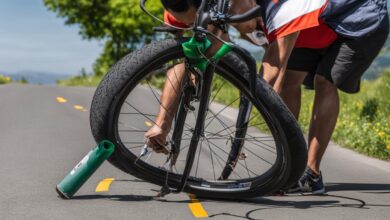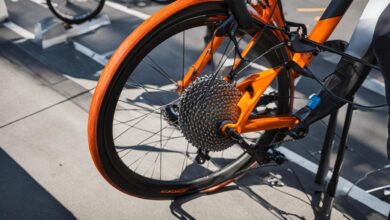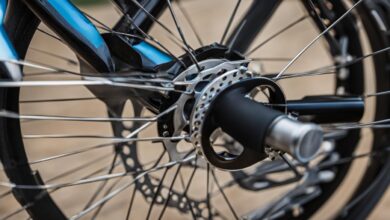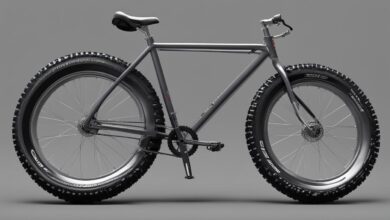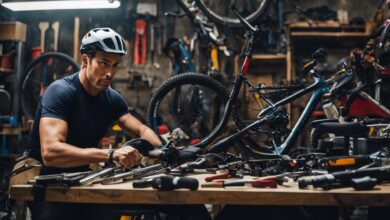Optimize Your Ride: Cycling Cleat Positioning for Efficiency

Are you looking to improve your cycling efficiency and maximize your power on the bike? One often overlooked factor that can make a significant difference is the positioning of your cycling cleats. Proper cleat placement is crucial for enhancing power transfer, increasing comfort, and preventing injuries during your rides. In this article, we will explore the importance of cycling cleat positioning and provide practical tips to help you optimize your setup for maximum performance.
Key Takeaways:
- Correct cleat positioning is essential for improving cycling efficiency and power transfer.
- Optimizing cleat position can enhance comfort and reduce the risk of common cycling injuries.
- Lateral positioning, cleat rotation, and fore and aft positioning are key factors to consider for proper cleat placement.
- Anatomical and biomechanical considerations play a crucial role in determining the optimal cleat position.
- Equipment factors such as bike fit, pedal system, and cycling shoes should be taken into account for accurate cleat positioning.
The Importance of Cleat Positioning for Efficiency
Cleat positioning plays a crucial role in optimizing cycling efficiency. By strategically placing your cleats on the bike pedals, you can enhance power transfer, increase comfort, and reduce the risk of injury. Understanding the anatomical and biomechanical considerations of cleat position allows you to make informed decisions that will improve your overall ride experience.
Proper cleat positioning is essential for efficient cycling power transfer. When your cleats are correctly aligned, they enable a direct transfer of power from your legs to the pedals, maximizing the force exerted on each stroke. This optimal power transfer leads to increased speed and improved performance on the bike.
In addition to power transfer, cleat positioning also influences comfort on the bike. When your cleats are positioned correctly, it helps to alleviate pressure points and hotspots, reducing discomfort during long rides. By achieving a balanced and ergonomic position, you can ride for longer periods without experiencing discomfort or pain.
Furthermore, cleat positioning is vital for injury prevention. Improper cleat placement can contribute to a range of injuries, such as knee strain, Achilles tendonitis, and plantar fasciitis. By aligning your cleats correctly, you can maintain proper biomechanics and reduce the risk of these common cycling injuries. Understanding the principles of cycling biomechanics and the impact of cleat position on your body’s alignment will help safeguard your long-term cycling health.
The Anatomical and Biomechanical Considerations
When positioning your cleats, it’s essential to consider the natural positions and movements of your feet and lower limbs. Factors such as foot pronation, ankle stability, and muscle engagement all play a role in determining the ideal cleat position.
– Foot Pronation: Understanding whether you have a neutral, pronated, or supinated foot position will influence the rotational aspect of your cleat placement. By accommodating your natural foot movement, you can pedal more efficiently and reduce the risk of strain on your joints.
– Ankle Stability: The alignment of your ankle joint plays a significant role in power transfer and injury prevention. Proper cleat positioning ensures that your ankle is stable and able to generate force efficiently during the pedal stroke.
– Muscle Engagement: The placement of your cleats affects the engagement of different leg muscles. Optimal cleat position allows for a well-balanced engagement of the quadriceps, hamstrings, and gluteal muscles, enhancing pedaling efficiency and muscle recruitment.
By considering these anatomical and biomechanical factors, you can optimize your cleat position to achieve the best possible cycling experience.
In the next section, we will explore the specific lateral positioning of cleats and its impact on comfort and power transfer.
*The image above showcases the importance of cleat positioning for optimizing efficiency in cycling.*
Lateral Positioning for Comfort and Efficiency
Lateral positioning is a critical aspect of cleat placement that affects both comfort and efficiency during cycling. It refers to the side-to-side placement of the cleats on the cycling shoe. By adjusting the lateral position, cyclists can optimize their Q-Factor, which is the distance between the crank arms or the stance between both feet.
Proper lateral positioning is essential for aligning the hips, knees, and ankles, promoting better power transfer and reducing the risk of knee and hip injuries. When the cleats are positioned too close together, the Q-Factor becomes narrow, potentially causing discomfort and instability. Conversely, if the cleats are set too far apart, the Q-Factor widens, leading to undue stress on the knee and hip joints.
To determine the ideal lateral positioning, it is crucial to consider factors such as bike fit, rider’s body dimensions, and foot anatomy. Consulting with a professional bike fitter can provide valuable insights into finding the optimal lateral position that suits an individual’s unique needs.
By aligning the cleats with the natural Q-Factor, cyclists can ensure proper biomechanics and enhance pedaling efficiency. This alignment allows for optimal engagement of the gluteal muscles, hamstring muscles, and quadriceps muscles, providing a balanced and powerful pedal stroke.
To summarize, correct lateral positioning of cleats plays a pivotal role in improving both comfort and efficiency on the bike. By aligning the cleats with the cyclist’s Q-Factor, it promotes optimal power transfer, reduces the risk of injuries, and ensures a more enjoyable and efficient ride.
Cleat Rotation (Float) for Natural Movement
Cleat rotation, also known as float, is a crucial consideration when optimizing cleat positioning for cycling efficiency. It refers to the amount of movement the foot can rotate on the pedal, allowing for accommodating natural foot movements such as pronation or supination.
By finding the optimal cleat float, cyclists can promote a more natural pedaling motion, enhancing foot stability and preventing injuries associated with restricted foot movement. Cleat rotation plays a significant role in maintaining proper biomechanics and reducing the risk of discomfort or strain.
When adjusting cleat rotation, it is essential to consider individual foot mechanics and pedaling style. Some riders may prefer a larger rotation range for more freedom of movement, while others may benefit from a more fixed position for greater stability.
Proper cleat rotation helps distribute forces evenly across the foot, reducing excessive pressure on specific areas and minimizing the risk of overuse injuries. It allows the foot to move fluidly throughout the pedal stroke, optimizing power transfer and efficiency.
“Cleat rotation plays a significant role in maintaining proper biomechanics and reducing the risk of discomfort or strain.”
During the pedal stroke, the foot naturally goes through a range of motion involving pronation (inward rotation) and supination (outward rotation). Cleat rotation allows the foot to follow its natural movement pattern, reducing stress on the ankle, knee, and hip joints.
However, it is crucial to find a balance between float and foot stability. Excessive float can lead to instability, while too little float can restrict natural foot movement. Adjusting cleat rotation can help find the optimal middle ground, providing both comfort and stability for improved performance.
Ensuring the appropriate cleat rotation is a multi-step process that involves bike fitting, biomechanical assessment, and personal preference. Consulting a professional bike fitter or a knowledgeable cycling coach can provide valuable insights and guidance in determining the optimal cleat rotation for individual needs.
Benefits of Cleat Rotation:
- Promotes natural foot movement
- Enhances foot stability
- Reduces the risk of injuries associated with restricted foot movement
- Improves power transfer and efficiency
- Optimizes biomechanics during the pedal stroke
By considering cleat rotation as part of the overall cleat positioning strategy, cyclists can enhance their riding experience, reduce the risk of injuries, and optimize their performance on the bike.
Followed by addressing cleat rotation, the next section will dive into the importance of fore and aft cleat positioning for power and comfort.
Fore and Aft Positioning for Power and Comfort
Proper cleat positioning involves not only the lateral and rotational aspects but also the fore and aft placement of the cleats. Fore and aft positioning refers to the placement of the cleats in the front and back halves of the shoe. This adjustment plays a crucial role in optimizing biomechanical alignment, power output, foot pressure distribution, and endurance during cycling.
By finding the correct fore and aft position, cyclists can achieve optimal alignment of the foot, knee, and hip, which is essential for maximizing power transfer and reducing strain on the muscles and joints. When the cleats are positioned too far forward, it can lead to excessive pressure on the ball of the foot and cause discomfort. On the other hand, if the cleats are placed too far back, it can result in a loss of power and inefficient pedal stroke.
Proper fore and aft positioning allows for biomechanical alignment that promotes efficient pedal stroke mechanics. It ensures that the major muscle groups involved in cycling, such as the quadriceps, hamstrings, and gluteal muscles, are engaged optimally. When the foot is aligned correctly with the pedal, it enhances power output through a more direct transfer of force.
In addition to power optimization, fore and aft positioning helps distribute foot pressure evenly across the entire foot. This even distribution reduces the risk of hotspots, numbness, and discomfort during longer rides, enhancing overall comfort and endurance.
It is important to note that fore and aft positioning can vary based on individual preferences, body proportions, and bike fit. Seeking professional advice from a bike fitter or cycling coach can help in determining the optimal cleat position for maximum power, comfort, and endurance.
Key Benefits of Fore and Aft Positioning:
- Maximizes power output by aligning the foot, knee, and hip
- Reduces strain on muscles and joints
- Distributes foot pressure evenly for enhanced comfort
- Optimizes pedal stroke mechanics
- Improves endurance during long rides
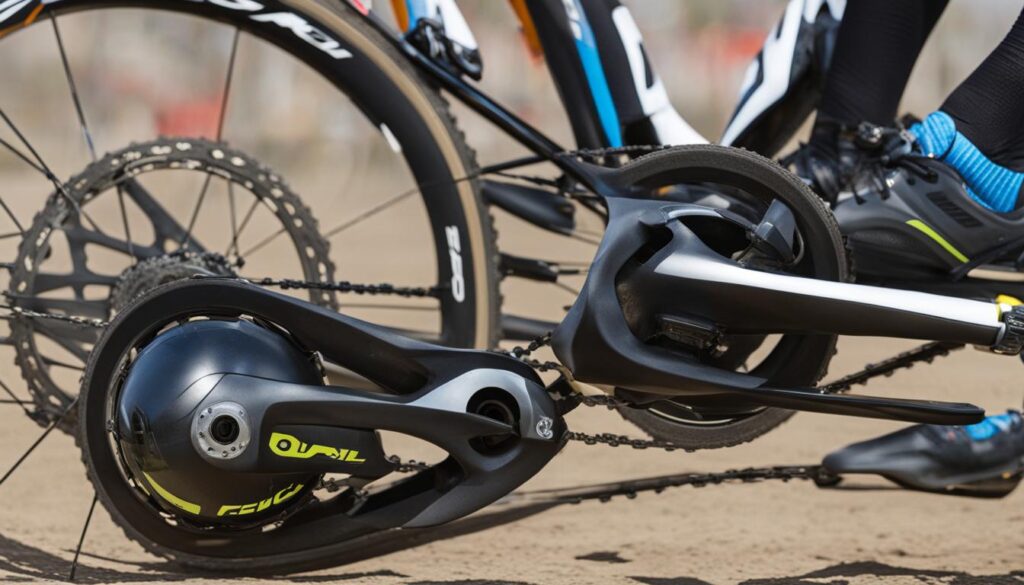
Fore and aft positioning plays a crucial role in optimizing power output, comfort, and endurance in cycling. Finding the correct position ensures biomechanical alignment, enhances pedal stroke mechanics, and minimizes strain on the body. By understanding and implementing proper cleat positioning techniques, cyclists can maximize their performance and enjoy a more efficient and comfortable ride.
The Role of Cleat Positioning in Cycling Efficiency
Cleat positioning plays a critical role in improving cycling efficiency, power transfer, pedaling performance, and muscle recruitment. Proper cleat placement allows cyclists to optimize their performance on the bike by maximizing the output of each pedal stroke and minimizing energy loss.
When the cleats are positioned correctly, the foot is aligned in such a way that it engages the major muscle groups involved in pedaling, such as the quadriceps, hamstrings, and gluteal muscles. This optimal muscle recruitment leads to better power generation and improved cycling efficiency.
By placing the cleats in the right position, cyclists can ensure that their biomechanics are optimized for efficient power transfer. The alignment of the foot, ankle, knee, and hip joints is crucial in facilitating a smooth and powerful pedal stroke.
Additionally, proper cleat positioning helps distribute the pressure evenly across the foot, reducing the risk of discomfort or pain during long rides. It also minimizes the chance of developing overuse injuries, such as tendonitis or knee pain, by reducing excessive stress on specific muscles and joints.
“Proper cleat positioning allows for optimal muscle recruitment and enhances power transfer, resulting in improved cycling efficiency and performance.”
To understand the role of cleat positioning in cycling efficiency, it is important to consider different factors such as the cyclist’s anatomy, pedaling technique, and bike fit. Each cyclist may have unique considerations when it comes to cleat positioning, and experimentation may be necessary to find the optimal position for individual performance and comfort.
Table 1: Key Factors in Cleat Positioning
| Factor | Impact |
|---|---|
| Anatomical Considerations | Affects alignment and muscle engagement |
| Bike Fit | Optimizes alignment of the foot, knee, and hip |
| Pedaling Technique | Influences foot movement and power transfer |
It is recommended to consult with a professional bike fitter or a cycling coach to assess and adjust cleat positioning. They can provide guidance based on individual needs and goals, taking into account factors such as riding style, discipline, and any existing biomechanical issues.
By understanding and optimizing cleat positioning, cyclists can unlock greater cycling efficiency, improve power transfer, enhance pedaling performance, and reduce the risk of injuries. Investing time and effort into finding the perfect cleat position can make a significant difference in overall cycling performance and enjoyment.
The Importance of Cleat Positioning for Injury Prevention
Correct cleat positioning is crucial for injury prevention in cycling. Improper cleat placement can lead to discomfort, foot numbness, and hot feet, increasing the risk of overuse injuries. By paying attention to cleat position, cyclists can reduce the likelihood of these issues and ride pain-free.
Proper cleat positioning plays a significant role in preventing injuries during cycling. When the cleats are positioned correctly, it helps distribute pressure evenly throughout the foot, reducing the chance of discomfort and foot numbness. Additionally, proper cleat position promotes optimal biomechanics, preventing strain on the muscles and joints and reducing the risk of overuse injuries.
There is a direct correlation between cleat positioning and injury prevention. The placement of the cleats affects the alignment of the entire lower body, including the feet, knees, and hips. When these joints are properly aligned, it minimizes the stress placed on them during cycling, reducing the risk of injuries such as patellofemoral pain syndrome, IT band syndrome, and Achilles tendonitis.
Another important aspect of cleat positioning for injury prevention is ensuring that the cleats are adjusted to the individual’s foot anatomy and pedaling style. Each cyclist may have different foot mechanics, such as pronation or supination, and finding the right cleat position can help accommodate these natural movements and prevent discomfort or strain.
One common issue associated with improper cleat positioning is hot feet, which occurs when there is excessive pressure or friction on the soles of the feet. This can lead to discomfort and potentially even blisters. By adjusting the cleat position to alleviate pressure points, cyclists can prevent hot feet and maintain comfort throughout their rides.
In conclusion, cleat positioning is essential for injury prevention in cycling. By ensuring proper cleat placement, cyclists can minimize the risk of discomfort, foot numbness, and hot feet, reducing the likelihood of overuse injuries. It is important for cyclists to understand the significance of cleat position and make any necessary adjustments to optimize their riding experience and maintain a pain-free journey.
Cleat Positioning Considerations for Different Cycling Disciplines
Cleat positioning is an essential element in optimizing cycling performance, and it becomes even more crucial when considering the specific demands and requirements of different cycling disciplines. Whether you are a road cyclist, a mountain biker, enjoy gravel riding, compete in triathlons, time trials, or participate in track cycling, understanding the unique needs of each discipline can help you maximize your cleat positioning for maximum efficiency.
Each cycling discipline places different demands on the cyclist’s power output, pedaling technique, and body positioning. Therefore, cleat placement must be adjusted accordingly to meet these demands. Let’s take a closer look at how cleat positioning considerations can vary across different cycling disciplines:
Road Cycling
In road cycling, where speed and endurance are paramount, cleat positioning plays a significant role in optimizing power transfer and pedaling efficiency. Proper cleat placement can help reduce fatigue and ensure optimal muscle engagement throughout the ride. Additionally, road cycling often involves long-distance rides, so it’s important to find a cleat position that provides both power and comfort over extended periods.
Mountain Biking
Mountain biking requires a different approach to cleat positioning due to the unique challenges of off-road terrain. Cleat placement in mountain biking must balance power delivery with maneuverability, as riders need to quickly adjust their foot position for technical maneuvers. Furthermore, the rugged and unpredictable nature of mountain biking necessitates cleat positions that provide stability and control while navigating rough trails and obstacles.
Gravel Riding
Gravel riding combines elements of road cycling and mountain biking, requiring a versatile approach to cleat positioning. The cleat position for gravel riding should strike a balance between efficient power transfer on paved surfaces and the ability to handle rough, uneven terrain. Finding the right cleat position can enhance both speed on flat sections and stability on gravel roads.
Triathlon
In triathlon, efficient cleat positioning is crucial for both the bike leg and the subsequent running leg. Triathletes need a cleat position that maximizes power output without compromising their ability to transition smoothly from cycling to running. The right cleat placement can minimize the energy expended during the bike leg while ensuring a seamless transition to the run leg without discomfort or injury.
Time Trial
In time trials, where every second counts, cleat positioning is vital for maximizing aerodynamics and power output. The cleat position should facilitate a streamlined body position and allow for optimal application of force during the pedal stroke. Fine-tuning the cleat position can make a significant difference in time trial performance and overall speed.
Track Cycling
Track cycling places a premium on speed and explosive power, making cleat positioning critical for optimal performance. The cleat position should enable quick acceleration from a standing start, efficient power transfer during high-speed sprints, and stability during banked turns. Finding the right cleat position can enhance track cyclists’ ability to generate maximum power and maintain control on the velodrome.
By recognizing the unique demands and requirements of different cycling disciplines, cyclists can tailor their cleat positioning to optimize performance and achieve their goals. Experimenting with different cleat positions, seeking professional bike fitting, and considering individual biomechanics can further refine the optimal cleat position for each cyclist’s specific needs.
The Role of Equipment in Cleat Positioning
Cleat positioning is a critical aspect of optimizing cycling efficiency and performance. While factors such as body mechanics and technique play a significant role, the equipment used also has a direct impact on cleat positioning. When fine-tuning your cleat position for maximum power transfer, comfort, and injury prevention, several equipment factors should be taken into consideration:
- Bike Fit: A proper bike fit ensures that your body is in alignment and optimally positioned on the bike. It affects various aspects of cycling, including cleat positioning. A bike fit expert can help assess your position on the bike and recommend adjustments that can enhance cleat placement.
- Bottom Bracket Width: The bottom bracket width of your bike affects the lateral positioning of your cleats. It determines the distance between your feet, known as the Q-factor. Cleat position adjustments may be necessary if your bike’s bottom bracket width is narrower or wider than your natural stance.
- Pedal System: Different pedal systems have varying cleat designs and engagement mechanisms. These variations can influence the positioning and float options available. Whether you’re using a Look, Shimano, or Speedplay pedal system, understanding the specific cleat model and its compatibility with your shoes is crucial for optimal cleat positioning.
- Cleat Model: Cleats come in different models with varying features, such as float and adjustment options. The selection of the right cleat model for your riding style and biomechanics is essential. Some cleats offer a higher degree of float, allowing for more natural foot movement, while others provide a fixed position for maximum power transfer. Consider experimenting with different cleat models to find the one that suits your needs best.
- Cycling Shoes: The design and fit of your cycling shoes can also impact cleat positioning. Different shoe brands and models have varying sole thickness and curvature, which can affect the fore and aft position or the overall feel of cleat placement. Ensure that your shoes provide a secure fit and have adequate compatibility with your chosen pedal system and cleat model.
By considering these equipment factors and integrating them into your cleat positioning strategy, you can fine-tune your cycling cleat setup for improved efficiency and performance.
Cleat Positioning Equipment Factors
| Equipment Factor | Description |
|---|---|
| Bike Fit | An optimal bike fit ensures proper body alignment and can influence cleat positioning recommendations. |
| Bottom Bracket Width | The distance between your feet, known as the Q-factor, is influenced by the bottom bracket width of your bike. |
| Pedal System | Different pedal systems have varying cleat designs and engagement mechanisms, affecting cleat positioning options. |
| Cleat Model | Choosing the right cleat model based on float options and adjustment capabilities is essential for optimizing cleat positioning. |
| Cycling Shoes | The design and fit of cycling shoes can affect cleat positioning and overall comfort on the bike. |
Conclusion
Cleat positioning is a critical factor in optimizing cycling efficiency. By understanding the key aspects of cleat position and considering individual needs and equipment factors, cyclists can enhance power transfer, prevent injuries, and improve overall performance on the bike.
Proper cleat positioning is essential for maximizing the benefits of cycling and enjoying a comfortable and efficient ride. By aligning the lateral position, cleat rotation, and fore and aft positioning, cyclists can achieve optimal biomechanical alignment, reducing the risk of strain and injury while maximizing power output.
Whether you’re a professional cyclist or a recreational rider, attention to cleat positioning can make a significant difference in your performance. Take the time to understand your unique needs, consult with experts if necessary, and experiment with different cleat positions to find what works best for you.
Investing in proper cleat positioning will not only enhance your cycling experience but also contribute to long-term injury prevention and performance enhancement. So, get out there, optimize your cleat position, and enjoy the ride to the fullest!
FAQ
What is the importance of cleat positioning for cycling efficiency?
Proper cleat placement is essential for optimizing power transfer, increasing comfort, and reducing the risk of injury while cycling.
How does lateral positioning of cleats contribute to comfort and efficiency?
Adjusting the side-to-side placement of the cleats (lateral positioning) helps align the hips, knees, and ankles, promoting better power transfer and reducing the risk of knee and hip injuries. It also allows for optimal Q-Factor, which is the distance between the crank arms or the stance between both feet.
What is cleat rotation (float) and how does it affect cycling efficiency?
Cleat rotation or float refers to the amount of movement the foot can rotate on the pedal. By adjusting cleat rotation, cyclists can accommodate natural foot movements such as pronation or supination. Finding the optimal cleat float promotes a natural pedaling motion, enhances foot stability, and helps prevent injuries associated with restricted foot movement.
How does fore and aft positioning of cleats impact power and comfort?
Proper fore and aft positioning of cleats involves placing them in the front and back halves of the shoe. This alignment optimizes the foot, knee, and hip alignment, maximizing power output and reducing strain on muscles and joints. It also helps distribute foot pressure evenly, enhancing comfort and endurance.
What role does cleat positioning play in cycling efficiency?
Cleat positioning directly impacts cycling efficiency by improving power transfer and enhancing pedaling performance. Proper cleat placement allows for optimal muscle recruitment, minimizing energy loss, and maximizing the output of each pedal stroke.
How does cleat positioning contribute to injury prevention in cycling?
Correct cleat positioning is crucial for injury prevention in cycling. Improper cleat placement can lead to discomfort, foot numbness, and hot feet, increasing the risk of overuse injuries. Paying attention to cleat position can help reduce the likelihood of these issues and ride pain-free.
Are there different considerations for cleat positioning based on different cycling disciplines?
Yes, cleat positioning considerations may vary depending on the specific cycling discipline. Road cycling, mountain biking, gravel riding, triathlon, time trial, and track cycling each have different demands and requirements when it comes to cleat position. Understanding the specific needs of each discipline can help cyclists optimize their cleat positioning for maximum performance.
How does equipment impact cleat positioning?
Cleat positioning is influenced by various equipment factors, including bike fit, bottom bracket width, pedal system, cleat model, and cycling shoes. Each of these factors can impact cleat position and should be taken into consideration when optimizing cycling efficiency.
How can cleat positioning optimize cycling efficiency?
By understanding the key aspects of cleat position and considering individual needs and equipment factors, cyclists can enhance power transfer, prevent injuries, and improve overall performance on the bike. Proper cleat positioning is essential for maximizing the benefits of cycling and enjoying a comfortable and efficient ride.
